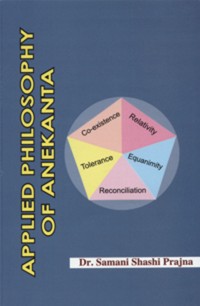There is co-existence of opposing pairs in our body too. In our body there are billions of cells. Every second, five crore cells are being destroyed and new five crore cells are being created. This co-existence is continual. If the cells did not die, then the body would become useless. If new cells were not created, then the body would break down. When both the activities co-exist, then the body lives on. Likewise, in our body exhalation and inhalation both co-exist, then the body lives on. There are two centres in our body: the gyan kendra or the centre of wisdom and the Kām Kendra or the center of passion. Both of them are opposites. The centre of passion weighs down the consciousness. The centre of wisdom raises the level of the consciousness. One is upward moving and the other is downward moving, the consciousness is in opposition to each other. Life rests on these two movements.[1] There are two types of nerves, sensory and motor nerves, right hemisphere and left hemisphere, sympathetic and parasympathetic nervous system (in āyurveda-idā nādi and pingalā nādi) works with full co-operation.
In science, there are two centres referred to as glands. One is the pineal-pituitary gland and the other the gonads. The pineal and the pituitary are centers that promote wisdom. Gonads promote passions. Our consciousness depends on the functioning of the pineal and the pituitary. When the secretions of the pineal and pituitary reach gonads, then passions are inflamed. But when these secretions change, then the action of the hypothalamus changes and there begins the growth of wisdom. Both the opposing themes are built within our physical system. Opposing forces are acting in the creation of the body, in the creation of nature, and in the creation of electricity too. In the world of electricity, both the negative and the positive energies work together. If there were only the positive and no negative, then no electricity would be produced. It is compulsory for both the positive and the negative to exist for electricity to be produced. Thus our entire existence is characterized by opposing pairs.
It is quiet relevant to quote the series of pairs as mentioned in the thesis, ‘Anekantvada through Paintings’,to highlight the very nature of objective world having pairs.
- Pratyaśha: Paroksa (Direct and Indirect)
- Rūpa: Arūpa (Form and Formless)
- Mitra: Śatru (Friend: Foe)
- Śiti: Śiti (Black: White)
- Janma: Maraṇa (Life: Death)
- Adhyātma: Laukika Dharma (Spiritual: Mundane Customs)
- Śaraṇa: Āśaraṇa (Shelter and Shelterlessness)
- Saṃyama: Asaṃyama (Restraint and Unrestraint)
- Lipta: Nirlipta (Attached: Detached)
- Harṣa: Viṣāda (Enjoyment: Misery)
- Dharma: Adharma (Violence: Non-violence)
- Śuci: Aśuci (Beauty: Non-beauty)
- Kendra: Paridhi (Centre: Circumference)
- Yukta: Mukta (Coalesced: Liberated)
- Śuddha: Aśuddha (Pure: Impure)
- Antaḥ: Bāhya (Internal: External)
- Sukha: Dukha (Happiness and Sorrow)
- Śītala: Uṣṇa (Coolness: Brightness)
- Kṛṣna: Śukla (Waning Moon: Waxing Moon)
- Antarmukhi: Bahirmukhi (inwardly Drawn: Outwardly Drawn)
- Gati: Agati (Movement: Non-movement)
- Jīva: Ajīva (Living: Non-living)
- Sāpekṣa: Nirpekṣa (Relatedness: Unrelatedness)
- Praṣna: Uttara (Question: Answer)
- Svarga: Naraka (Heaven: Hell)
- Sacela: Acela (Attired: Unattired)
- Bandhana: Mukti (Bondage: Liberation)
- Abhāva: Ananta (Absence: Fullness)
- Khaṇdana: Maṇdana (Refuting: Establishing)
- Padārtha: Ātmā (Matter: Soul)[2]
It is a common question in the minds of many that the assertion of anekānta as both being and non-being is self-contradictory. In our day-to-day experience we don't perceive these two opposing ideas one and the same time. But the above mentioned examples of co-existence of opposing pairs proves that they are real nature of the subject or the object.
 Dr. Samani Shashi Pragya
Dr. Samani Shashi Pragya

